Why Metal Headstones Offer Lasting Memorial Solutions
Metal headstones for graves give families a durable, highly customizable alternative to stone markers. Whether you choose a classic bronze plaque on granite or a sleek stainless-steel stake, metal memorials deliver sharp detail and proven longevity.
Key Metal Types
- Bronze – Premium choice, develops protective patina, 18-230 lbs
- Aluminum – Lightweight, silvery finish, weather-resistant
- Stainless Steel – Nearly indestructible, centuries of durability
- Zinc ("White Bronze") – Historic option, famous for crisp detail
Typical Price Ranges
- Aluminum markers: from $300
- Custom bronze with granite: $2,219-$2,753
- Stainless steel stakes: $65-$80
Why Families Pick Metal
- Superior corrosion resistance
- Precise inscriptions & laser graphics
- Lighter weight than full-granite monuments
- Broad design and finish options
Points to Check First
- Every cemetery sets its own material and size rules
- Some metals need clear-coat protection in coastal areas
- Professional installation may be required for warranty
Metal grave markers have been around since the 1870s, starting with zinc monuments sold as "white bronze." Many of those Victorian pieces still stand today—proof that well-made metal memorials endure. Modern manufacturers build on that legacy with powder-coated steel, advanced bronze casting, and stainless alloys engineered to resist the harshest weather.
As American Mortuary Coolers professionals, we see how the same durability standards that matter for mortuary equipment also apply to permanent memorials. Metal markers meet those standards—and often exceed the lifespan of traditional stone.
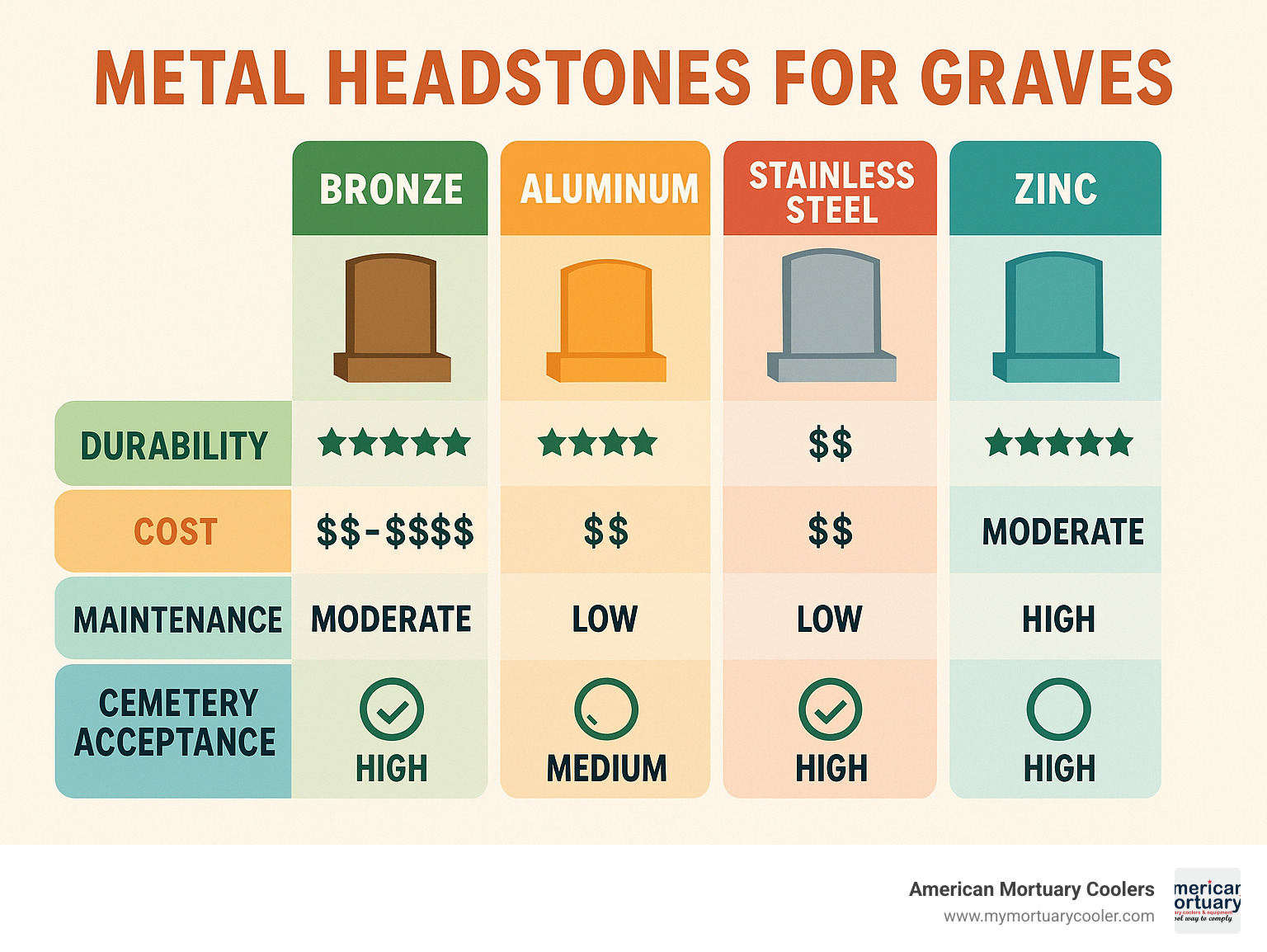
Basic metal headstones for graves terms:
What Are Metal Headstones for Graves?
When most people think of grave markers, they picture carved granite or marble headstones. But metal headstones for graves offer a beautiful alternative that's been around for over 150 years. These memorial markers are crafted from durable metals like bronze, aluminum, stainless steel, and historically, zinc.
What makes metal markers special? Unlike stone headstones that are carved from solid blocks, metal memorials can be cast in molds, stamped with precision, or laser-cut to create incredibly detailed designs. The result is sharp, lasting inscriptions that often outlast their stone counterparts.
Most modern metal headstones for graves come in two main styles: solid-cast markers that are formed as one piece, or hollow designs that are lighter and more cost-effective. Many feature powder-coated finishes that add an extra layer of protection against the elements.
These metal alternatives offer families more design flexibility at various price points. A flat bronze plaque mounted on a granite base combines the best of both worlds, while upright metal markers stand independently and make a bold statement.
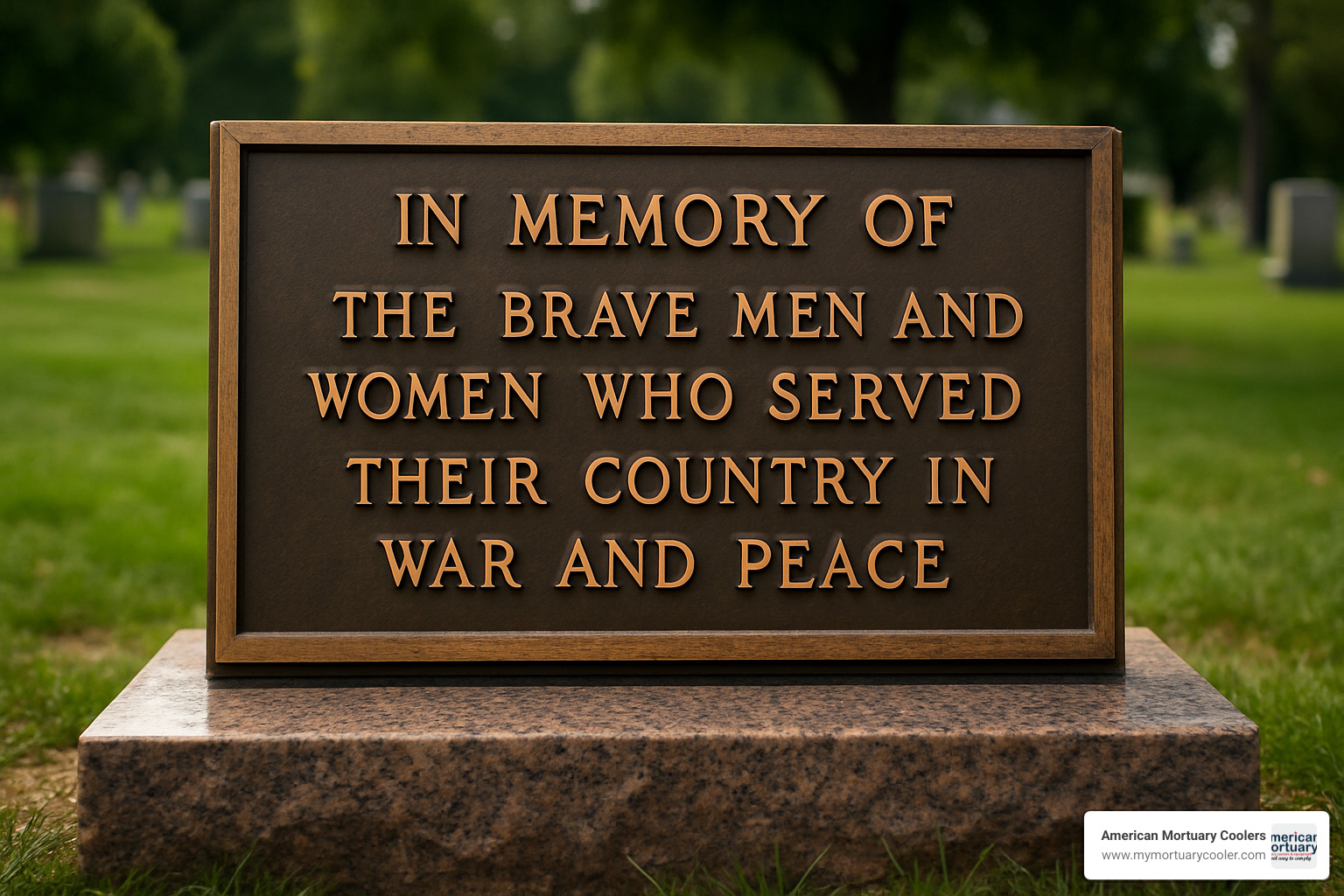
A Brief History of Metal Memorials
The story of metal grave markers takes us back to the Victorian era, when innovation met necessity in the cemetery industry. In 1873, the first zinc grave markers appeared, cleverly marketed as "white bronze" despite containing no bronze at all.
The Monumental Bronze Company, founded in 1874, turned this marketing into a business empire. They understood that families wanted beautiful, lasting memorials but couldn't always afford expensive carved marble or granite. Their zinc monuments offered a solution that was both affordable and durable.
These white bronze markers weren't just cheaper - they were actually superior in many ways. The zinc naturally formed a protective coating that resisted corrosion, while the casting process allowed for incredibly sharp details that would remain clear for decades.
The company thrived until World War I changed everything. In 1914, the demand for munitions shifted their focus away from cemetery monuments. By 1939, the Monumental Bronze Company had gone bankrupt, ending an era of zinc memorials.
Many of those 19th-century zinc markers still stand today with remarkably sharp inscriptions, proving that well-made metal memorials can truly last. You can spot these historic markers with a simple magnet test - since zinc isn't magnetic, a magnet won't stick to authentic white bronze markers.
Modern Categories of Metal Headstones for Graves
Today's metal headstones for graves have evolved far beyond those Victorian-era zinc markers, offering families a range of options that combine traditional craftsmanship with modern materials.
Upright bronze on granite represents the most popular choice among modern families. These markers feature detailed bronze plaques mounted on polished granite bases, typically measuring 24×12 inches to 28×16 inches. The weight varies dramatically - from 18 pounds for smaller markers up to 230 pounds for larger granite foundations.
Flat bronze markers have gained widespread acceptance, especially in veteran cemeteries. The VA uses these extensively, with standard dimensions of 24 inches long by 12 inches wide. At approximately 18 pounds, they include specialized anchor hardware for secure ground installation.
For families seeking maximum durability, stainless steel stakes offer practically indestructible memorials. These feature stainless steel plates mounted on tubes that extend 30+ inches deep into the ground, designed to last centuries while resisting all forms of corrosion.
Aluminum plaques provide a lightweight, weather-resistant option with an attractive silvery metallic finish. These require minimal maintenance while offering excellent durability, making them popular for both traditional and contemporary cemetery settings.
Types of Metals Used in Modern & Historic Grave Markers
When families choose metal headstones for graves, understanding the different metals available makes all the difference. Each type brings its own characteristics to a memorial, along with unique benefits that affect longevity and appearance over time.
Bronze stands as the gold standard of metal memorials. This remarkable material has earned its reputation as one of the most durable substances on earth. What makes bronze special is how it ages gracefully - developing a rich, natural patina that actually protects the metal underneath. While bronze markers cost more upfront than other options, they're built to honor memories for generations.
Aluminum offers families an excellent middle ground. This lightweight metal maintains its silvery appearance year after year while resisting weather damage at a fraction of bronze's cost. Installation becomes much easier thanks to aluminum's lighter weight.
Stainless steel brings modern durability to memorial design. Cemetery professionals often describe it as "practically indestructible," and for good reason. This metal fights off every type of corrosion and fits perfectly with contemporary memorial styles.
Powder-coated steel transforms ordinary steel into a weather-resistant memorial option. The powder coating process applies a dry powder that gets baked on under intense heat, creating a protective shell that keeps rust at bay for years.
Looking back at historic markers, pure zinc tells a fascinating story. These 19th-century memorials contained more than 99% pure zinc, which forms its own protective coating called zinc carbonate. This natural shield explains why so many Victorian-era markers still look sharp today, more than 150 years later.
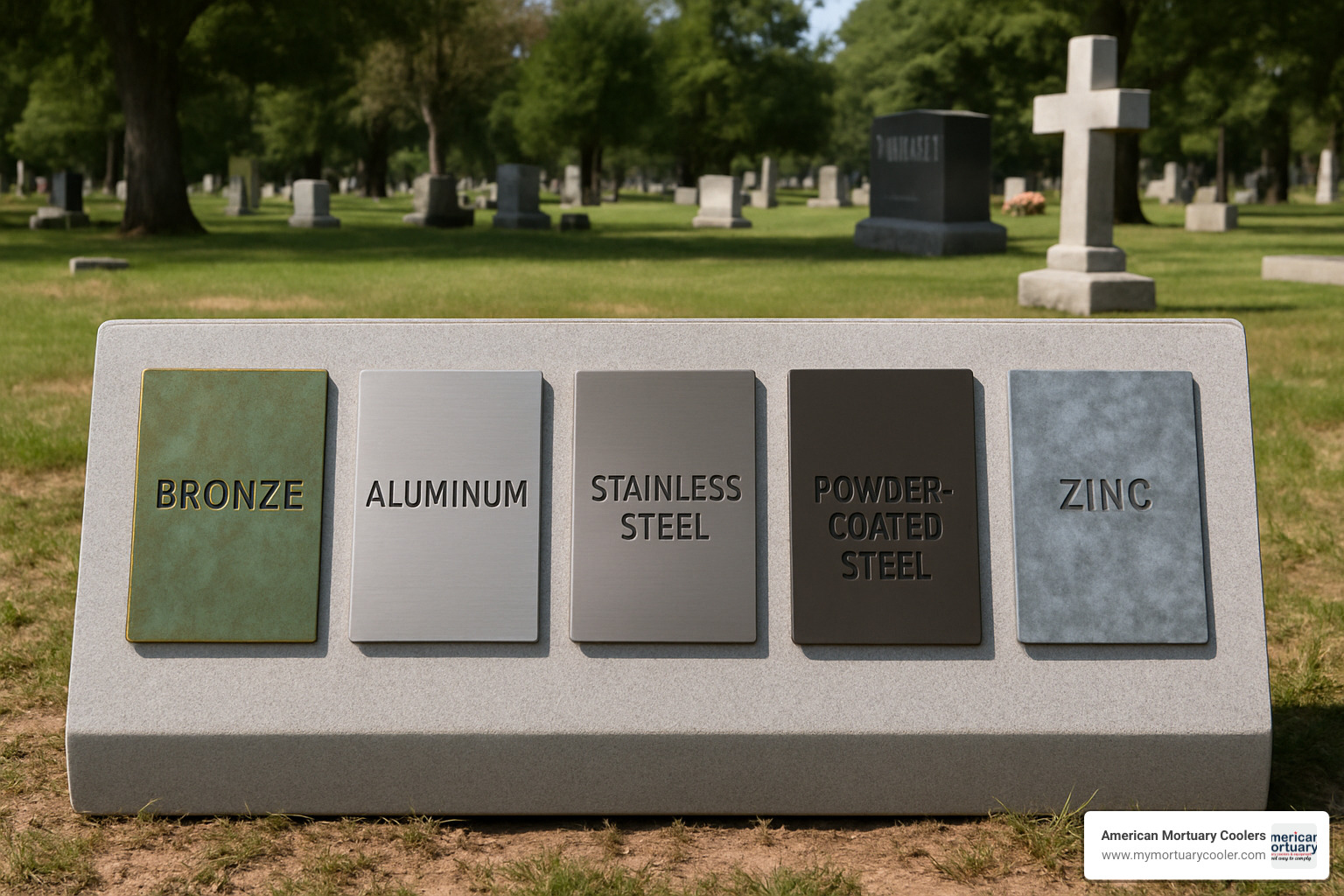
Key Properties & Appearance
Each metal develops its own character over time, and understanding these changes helps families set proper expectations.
Patina development creates some of the most beautiful aspects of metal memorials. Bronze gradually shifts from its original golden color to rich browns and eventually to soft greens, depending on local weather conditions. This patina isn't damage - it's actually the metal's way of protecting itself. Aluminum keeps its bright, silvery look throughout its lifetime, while stainless steel stays true to its original appearance.
Corrosion resistance varies significantly between metals, but all modern options perform well when properly cared for. Bronze and stainless steel lead the pack for long-term protection, while aluminum and powder-coated steel provide solid resistance with basic maintenance.
Weight differences affect everything from shipping costs to installation requirements. A simple flat bronze marker weighs about 18 pounds, while full granite and bronze combinations can tip the scales at 230 pounds. Aluminum markers feel surprisingly light in comparison.
The magnet test offers a simple way to identify mystery metals. Historic zinc markers won't attract a magnet at all, while steel-based memorials will grab onto one immediately.
Specialty & Veteran Options
The Department of Veterans Affairs operates one of the largest metal headstones for graves programs in the country, providing free markers for eligible veterans and their families.
VA bronze markers follow a standard design - flat bronze plates measuring 24×12 inches with a subtle 3/4-inch rise. These 18-pound markers come with all the anchor hardware needed for proper installation. The bronze naturally develops its protective patina over time while requiring very little maintenance from families.
Bronze medallions serve veterans buried in private cemeteries where families have already installed headstones. The VA offers three sizes to fit different memorial styles.
Service emblems can be incorporated directly into metal headstones through casting or etching processes. These permanent additions recognize military service, unit affiliations, and special honors earned during service.
For complete details about veteran memorial options, families can visit the VA memorial items page.
Durability, Maintenance & Common Repairs
Metal memorials are engineered for the long haul. Bronze and aluminum shrug off temperature swings, while stainless steel resists virtually every type of corrosion. Powder-coated steel performs well too—just inspect the coating every few years for chips so you can touch up before rust starts.
Historic zinc markers sometimes show "creep" (bulging panels), a problem modern solid-cast metals avoid thanks to better engineering.
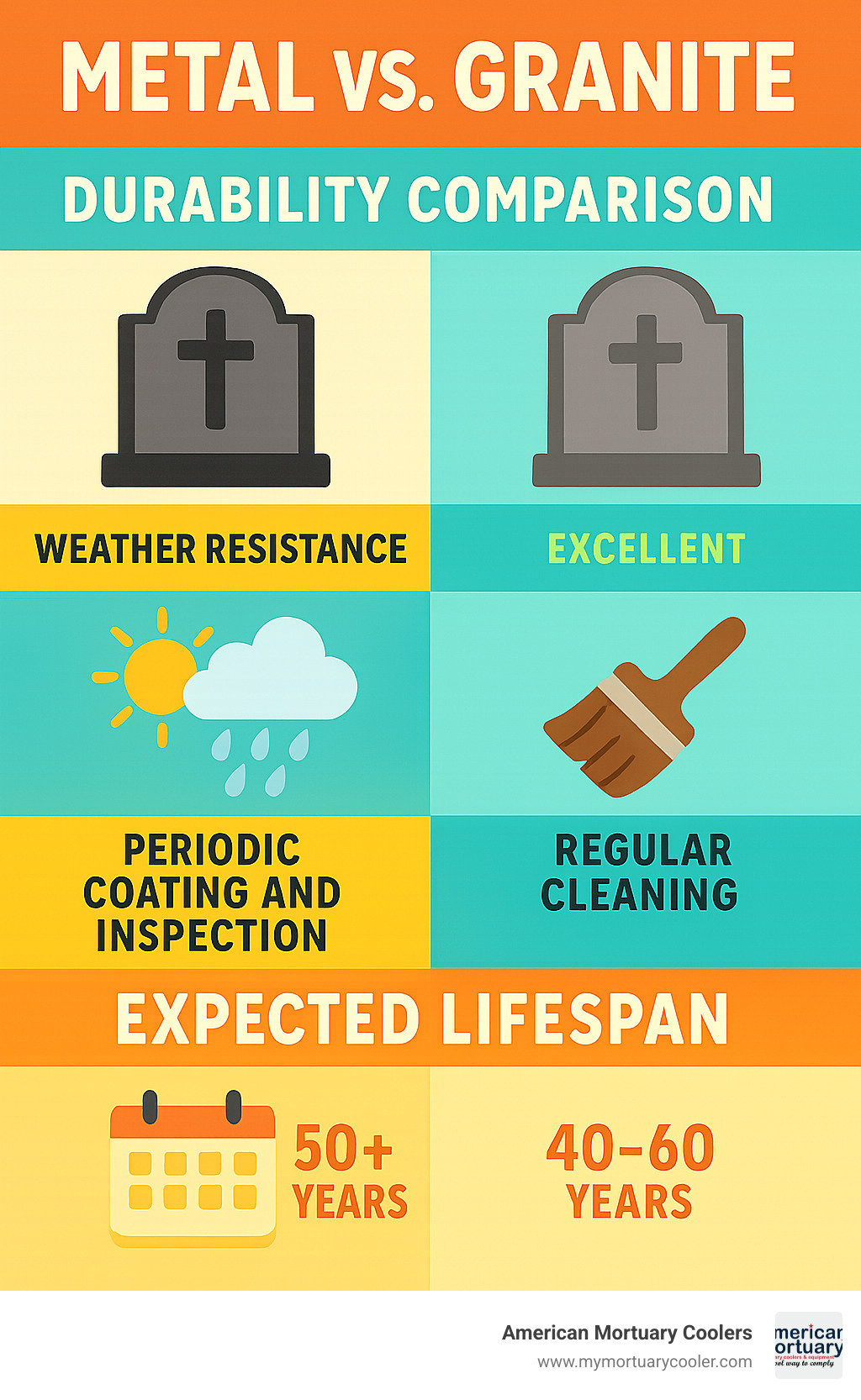
Cleaning & Routine Care
- Dust or rinse away debris during regular visits.
- Every few months, wash with a soft-bristle brush and pH-neutral soap; rinse thoroughly.
- Once a year, inspect for loose hardware or coating wear.
Avoid abrasive pads and power washers. For bronze, a light coat of carnauba wax keeps the patina even. Aluminum and stainless steel generally need nothing more than soap and water.
Need to swap a damaged vase? See our step-by-step guide to headstone vase replacement.
Repairing Damage
- Zinc seams: re-solder or bond with high-grade epoxy—never fill with concrete.
- Hairline cracks: specialty metal adhesives or professional welding.
- Corroded bolts: replace with stainless hardware to stop recurrence.
Most issues are easily fixed when caught early, so those quick annual inspections truly pay off.
Customization, Ordering & Installation Process
Design technology now lets families turn metal into a personal canvas. Options include:
- Laser graphics for photos or landscapes
- 3-D bas-relief elements for added depth
- Color patinas or painted accents sealed under clear coat
- Script, block or custom fonts—even handwriting samples
- QR codes that link visitors to online tributes
Before production, your supplier secures cemetery approval (size, material, and foundation specs). Most companies handle the paperwork so you don’t have to.
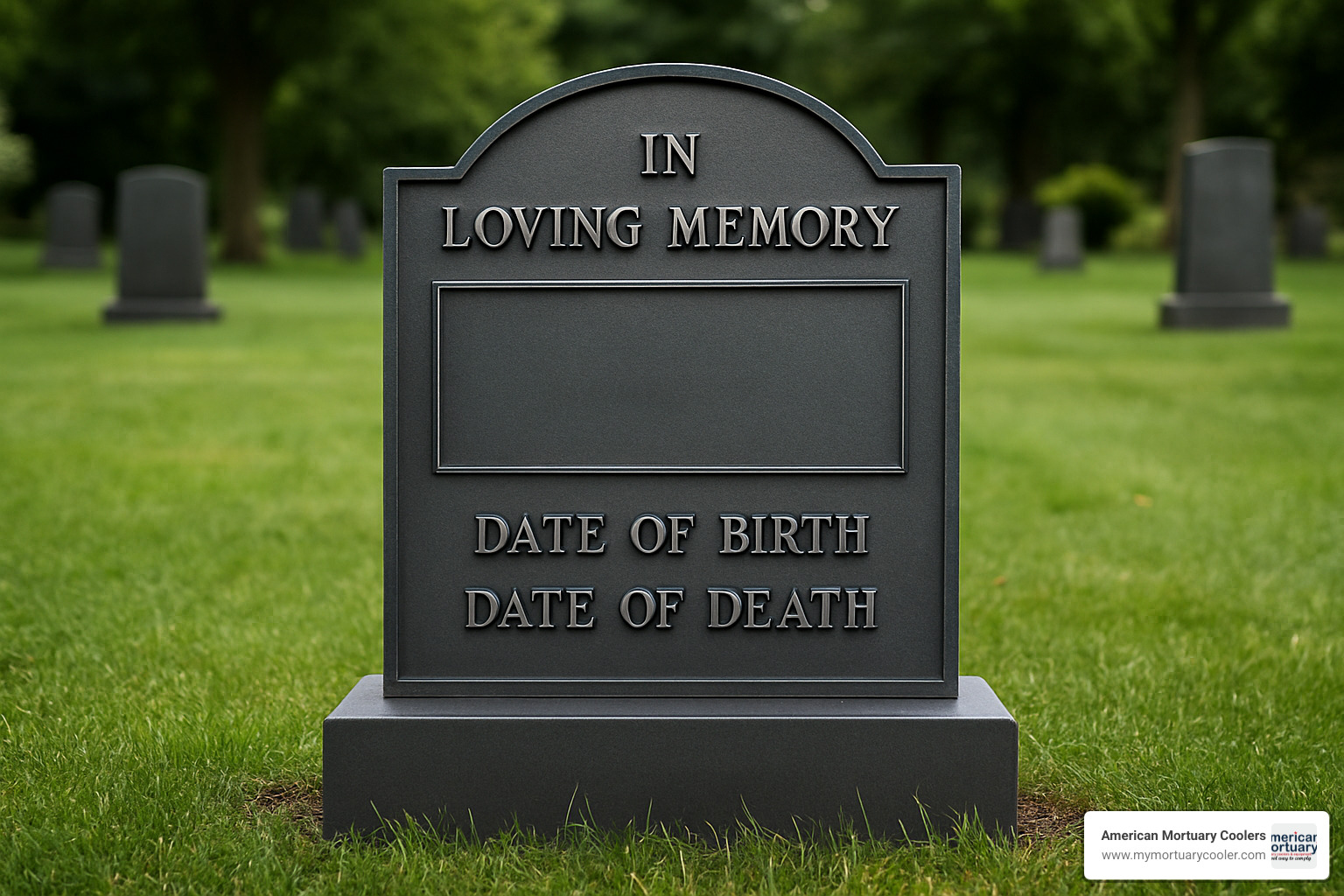
Personalizing Metal Headstones for Graves
Popular add-ons include kiln-fired porcelain photos, cast military or religious emblems, hobby imagery, and nature motifs. For detailed engraving on urns or keepsakes, explore our guide to engraved name plates.
From Quote to Graveside: Step-by-Step (Typical 6-12 Weeks)
- Consultation & design (Week 1)
- Digital proof & cemetery permit (Weeks 2-3)
- Manufacturing (Weeks 4-9)
- Quality check & clear coat (Week 10)
- Delivery & professional installation (Weeks 11-12)
This streamlined timeline still allows plenty of room for custom art without delaying interment plans.
Cost Comparison & Regulatory Considerations
Planning for metal headstones for graves means understanding both the financial investment and the rules that govern their installation. Having worked in the funeral industry, I've seen how these costs can vary dramatically based on your choices and location.
Entry-level aluminum markers start around $300, making them an accessible option for many families. Stainless steel tribute stakes fall in the middle at $65-$80 and provide that practically indestructible durability we discussed earlier.
For families seeking more personalization, standard bronze plaques typically range from $500-$1,200 when mounted on granite bases. The premium option - custom bronze with granite - runs $2,219-$2,753 for standard sizes, but you're investing in a memorial that could outlast granite monuments by decades.
Don't forget the additional costs that can surprise families. Cemetery installation fees, foundation preparation, and shipping charges (especially for heavy bronze markers) can add several hundred dollars to your total. Some cemeteries also charge annual maintenance fees or require specific installation contractors.
When comparing metal headstones for graves to traditional granite, the value proposition becomes clearer. While granite headstones typically cost $1,000-$4,000, aluminum markers often cost 40-60% less with comparable durability. Bronze on granite costs about the same as solid granite but offers superior inscription clarity that won't fade over time.
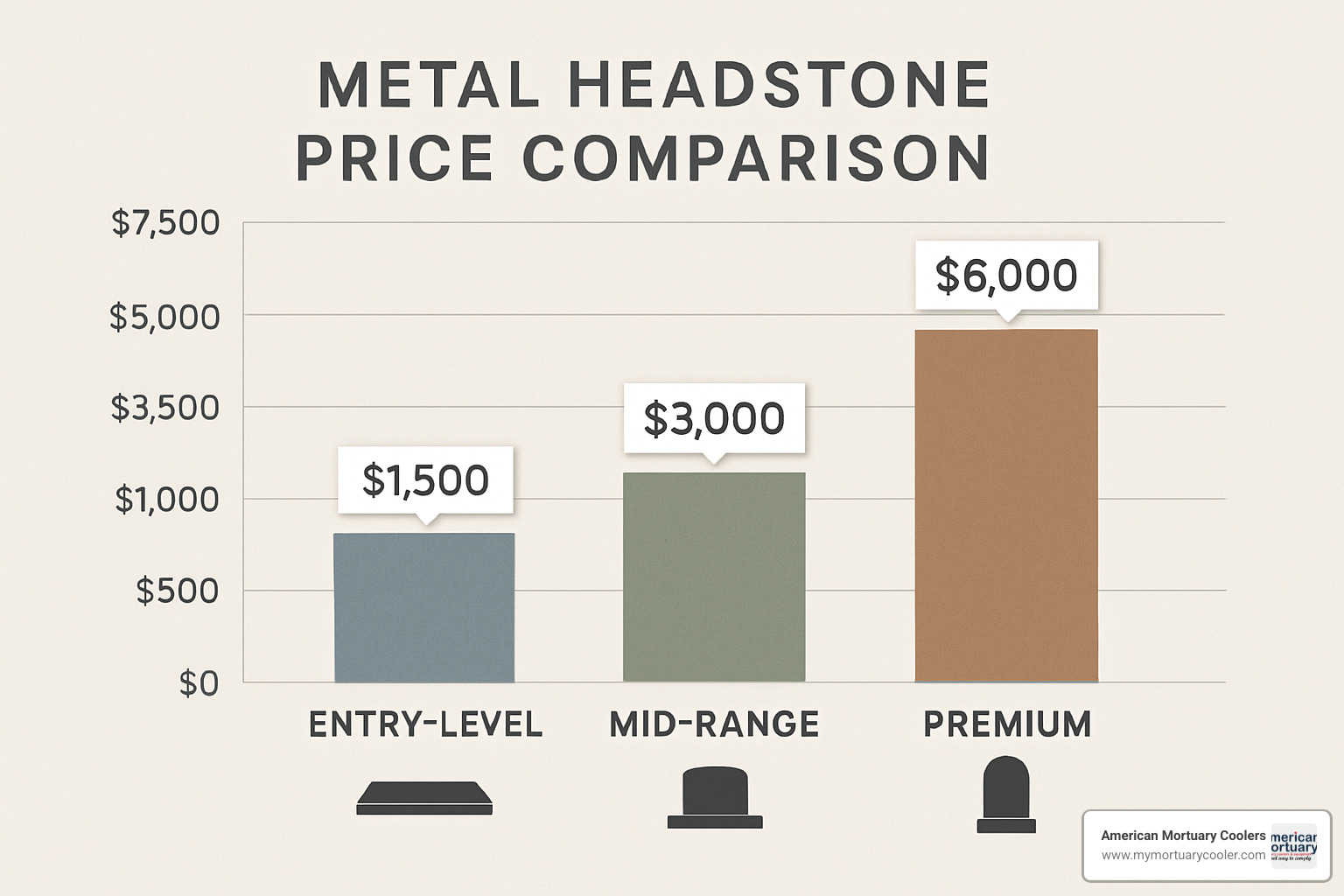
Cemetery Rules & Regional Variations
Every cemetery has its own requirements when it comes to metal headstones for graves. Some accept modern materials and designs, while others stick rigidly to traditional approaches.
Flat-only sections have become increasingly common in modern cemeteries. Groundskeepers prefer them because they can mow right over flush-mounted markers without stopping to trim around upright monuments. If your cemetery requires flat markers, this actually works in favor of metal options, since bronze and aluminum flat markers often cost less than granite alternatives.
Size restrictions vary widely. Most cemeteries limit markers to 24×36 inches or similar dimensions, but some historic cemeteries may have much stricter rules. Always check before you fall in love with a particular design.
Veteran sections typically welcome metal markers since the VA provides bronze options as standard. These sections often have uniform spacing requirements and approved emblems lists, but metal markers handle military insignia beautifully through casting or laser etching.
Historic districts present unique challenges. Some prohibit modern metals entirely, requiring period-appropriate materials that match the cemetery's original character. Others allow metal markers but restrict finishes to those available during the cemetery's founding era.
Climate plays a bigger role than many people realize. Coastal cemeteries often prefer stainless steel or specially treated bronze because salt air can accelerate corrosion in other metals. Northern regions favor materials that handle freeze-thaw cycles without cracking, while desert areas need UV-resistant finishes to prevent fading.
At American Mortuary Coolers, we understand how regulations can complicate memorial planning. While we specialize in mortuary equipment rather than headstones, our experience with cemetery requirements across the contiguous 48 states has shown us how much these rules vary. The key is working with reputable suppliers who handle cemetery approval paperwork and understand local requirements.
Frequently Asked Questions about Metal Headstones
Are zinc ("white bronze") headstones still made today?
The short answer is no - zinc headstones are no longer manufactured for cemetery use today. This might surprise you, especially since many people still encounter these beautiful historic markers in older cemeteries.
The Monumental Bronze Company, which dominated the zinc marker industry, ceased production in 1914 when World War I shifted their entire focus to munitions manufacturing. The company struggled financially after the war and eventually went bankrupt in 1939, bringing the era of zinc cemetery monuments to a complete end.
What's remarkable though - many of those historic zinc markers from the 1870s through 1914 remain in excellent condition today. Despite being well over 100 years old, these markers often display incredibly sharp inscriptions and intricate details. This exceptional preservation comes from zinc's natural ability to form a protective coating that resists corrosion.
If you're drawn to the appearance of those historic "white bronze" markers, modern alternatives like bronze, aluminum, and stainless steel offer similar durability benefits with the advantage of improved manufacturing techniques and protective coatings that weren't available in the 19th century.
How do metal headstones withstand harsh winters or seaside air?
This is one of the most common concerns families have about metal headstones for graves, and it's a smart question to ask. The good news is that modern metal markers are specifically engineered to handle whatever Mother Nature throws at them.
Winter weather poses unique challenges with its freeze-thaw cycles, ice formation, and temperature swings that can crack lesser materials. Bronze develops that beautiful protective patina over time, which actually shields the underlying metal from freeze-thaw damage. Aluminum has excellent thermal expansion properties that prevent cracking, while stainless steel remains virtually unaffected by temperature fluctuations.
Seaside environments present their own set of challenges with salt spray and humid air that can corrode many materials. Marine-grade stainless steel is specifically formulated for this exact situation. Quality markers also feature protective clear coats that create an additional barrier against salt spray, and proper drainage design prevents salt water from pooling on the surface.
The proof is in the results. Many metal markers from the early 1900s continue to look great in harsh climates across the country, demonstrating that quality metal construction truly stands the test of time. Modern protective coatings and improved alloys make today's markers even more resilient than those historic examples.
Can every cemetery accept metal headstones for graves?
Unfortunately, not all cemeteries accept metal headstones for graves, and the rules can vary quite dramatically from one location to another. You really need to do your homework before making any purchases.
Most public and private cemeteries readily accept bronze markers mounted on granite bases - this combination has become quite standard across the country. VA-approved metals are widely welcomed in veteran sections, and standard aluminum or stainless steel markers typically get approval as well.
However, some cemeteries have restrictions that might surprise you. Historic cemeteries often require period-appropriate materials only, which could rule out modern metals entirely. Religious cemeteries might have specific material or design requirements based on their faith traditions. Some upscale private cemeteries mandate granite or marble exclusively. Green burial grounds may prohibit non-biodegradable materials as part of their environmental mission.
Here's my advice: always verify cemetery regulations before purchasing any metal headstone. Most reputable manufacturers will handle this verification process and obtain necessary permits at no additional charge - it's just good business practice and saves everyone headaches down the road.
Conclusion
When you're choosing a lasting tribute for someone special, metal headstones for graves offer something truly remarkable - they've been honoring memories beautifully for over 150 years, and they're still going strong today.
Think about it: those Victorian-era zinc markers from the 1870s? Many still look crisp and clear today, their inscriptions as readable as the day they were installed. That's the kind of lasting power you get with quality metal memorials.
The beauty of metal markers lies in their flexibility. Whether your budget calls for a practical aluminum marker starting around $300 or you're planning a premium bronze memorial in the $2,000+ range, there's a metal option that fits. Unlike stone that can weather and fade over time, metal markers often get more beautiful with age - especially bronze, which develops that rich, protective patina that actually helps preserve the memorial underneath.
Every family's situation is different, and that's where metal really shines. Need something lightweight for easy installation? Aluminum's got you covered. Want something that'll last centuries with virtually no maintenance? Stainless steel is your friend. Looking for that classic, timeless appeal? Bronze on granite combines the best of both worlds.
The customization possibilities are honestly amazing these days. From laser-etched photographs to QR codes linking to online memorials, modern metal headstones for graves can tell your loved one's story in ways that would have seemed impossible just a generation ago.
Here's what we've learned from our years in the funeral industry: the families who are happiest with their memorial choices are the ones who took time to understand their options and worked with professionals who really know their stuff. Don't rush the process. Talk to your cemetery first about their rules. Get quotes from multiple sources. And most importantly, choose something that feels right for the person you're honoring.
At American Mortuary Coolers, we've spent years crafting custom solutions for funeral professionals across all 48 contiguous states. While our specialty is mortuary equipment and coolers, we understand that every detail matters when you're creating something meaningful. The same attention to quality and durability that goes into our custom coolers is what you should expect from any memorial you choose.
Your loved one deserves a tribute that lasts. Metal headstones offer that durability, combined with the personal touches that make each memorial unique. Whether you choose the warm patina of bronze, the clean lines of stainless steel, or the practical beauty of aluminum, you're investing in decades of dignified remembrance.
For more information about modern funeral equipment and memorial solutions, visit our website.
















